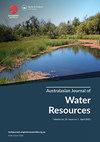An evaluation of a multi-day rainfall – runoff volume – peak discharge transform for flood frequency estimation
IF 2.2
Q2 WATER RESOURCES
引用次数: 5
Abstract
ABSTRACT A new method to estimate design discharge quantiles is described based on converting multi-day rainfall P to flood event runoff RO, factored to generate discharge Q. The so-called PROQ transfer function is founded on simple flood volume-peak and GRADEX rainfall-runoff tanh relationships. Performance testing of PROQ, in both at-site and regional design flood contexts up to 1 in 100 annual exceedance probability, was made using south east Queensland streamgauge data. A statistical comparison against proven methods showed that the PROQ transform has significant potential as an alternative for design flood estimation. An example of how PROQ can be used within a design flood framework and recommendations for further enhancement are provided. Abbreviations: AEP: Annual exceedance probability; AMS: Annual maximum series, extracted from the flood record at a gauge site; ANOVA: Analysis of variance; ARR: Australian Rainfall and Runoff guidelines; A-S: At-site. Describes a set of methods to estimate design flood quantiles by statistical analysis of the flood record at an individual gauge site; E: Nash–Sutcliffe efficiency; FFA: Flood frequency analysis; G-B: Multiple Grubbs-Beck test recommended by ARR 2019 for low flow censoring. Used for at-site flood frequency analysis; GEV: General extreme value probability distribution; GRADEX: Gradient of extreme values. Design flood probability concept originating in France based on parallelism of rainfall and runoff quantile curves; L: Retention of rainfall within the catchment during flood event, expressed as a depth; LP3: Log Pearson 3 probability distribution; P: Rainfall depth; PRM: Probabilistic Rational Method. An ARR method for ungauged, undeveloped Australian catchments superseded in 2016; PROQ: Transfer function based on converting P to RO and then factoring RO to estimate Q; PW: Palmen and Weeks. Regional method for ungauged, undeveloped Queensland catchments developed by Palmen and Weeks (2011); R: Retention curve number. Used in probabilistic charting of design floods based on PROQ; RE: Absolute relative error; REG: Regional. Describes a set of methods to estimate design flood quantiles using information obtained from at-site analyses of several representative catchments within a region; RO: Flood event runoff depth; SR30: Strike rate of estimates within ±30% tolerance.多日降雨-径流量-洪峰流量变换对洪水频率估计的评价
摘要描述了一种新的估算设计流量分位数的方法,该方法基于将多日降雨量P转换为洪水事件径流量RO,并将其作为产生流量Q的因子。所谓的PROQ传递函数建立在简单的洪水量峰值和GRADEX降雨-径流量tanh关系的基础上。在现场和区域设计洪水情况下,PROQ的性能测试(年超越概率高达1/100)是使用昆士兰东南部的测流仪数据进行的。与已验证方法的统计比较表明,PROQ变换作为设计洪水估算的替代方案具有巨大的潜力。提供了如何在设计洪水框架内使用PROQ的示例以及进一步增强的建议。缩写:AEP:年度超越概率;AMS:年最大序列,从测量点的洪水记录中提取;方差分析:方差分析;ARR:澳大利亚降雨和径流指南;A-S:在现场。描述了一套通过对单个测量点的洪水记录进行统计分析来估计设计洪水分位数的方法;E: 纳什-萨克利夫效率;FFA:洪水频率分析;G-B:ARR 2019推荐的多Grubb-Beck测试用于低流量审查。用于现场洪水频率分析;GEV:一般极值概率分布;梯度:极值的梯度。源自法国的基于降雨和径流分位数曲线平行性的设计洪水概率概念;L: 洪水事件期间集水区内的降雨保留量,以深度表示;LP3:对数Pearson 3概率分布;P: 降雨深度;概率推理方法。2016年被取代的澳大利亚未灌溉、未开发集水区的ARR方法;PROQ:基于将P转换为RO,然后分解RO来估计Q的传递函数;帕门和威克斯。Palmen和Weeks(2011)开发的昆士兰未开发集水区的区域方法;R: 保留曲线编号。用于基于PROQ的设计洪水概率图;RE:绝对相对误差;REG:区域。描述了一套使用从一个区域内几个代表性集水区的现场分析中获得的信息来估计设计洪水分位数的方法;RO:洪水事件径流深度;SR30:估计命中率在±30%公差范围内。
本文章由计算机程序翻译,如有差异,请以英文原文为准。
求助全文
约1分钟内获得全文
求助全文
来源期刊

Australasian Journal of Water Resources
WATER RESOURCES-
CiteScore
5.10
自引率
21.90%
发文量
25
期刊介绍:
The Australasian Journal of Water Resources ( AJWR) is a multi-disciplinary regional journal dedicated to scholarship, professional practice and discussion on water resources planning, management and policy. Its primary geographic focus is on Australia, New Zealand and the Pacific Islands. Papers from outside this region will also be welcomed if they contribute to an understanding of water resources issues in the region. Such contributions could be due to innovations applicable to the Australasian water community, or where clear linkages between studies in other parts of the world are linked to important issues or water planning, management, development and policy challenges in Australasia. These could include papers on global issues where Australasian impacts are clearly identified.
 求助内容:
求助内容: 应助结果提醒方式:
应助结果提醒方式:


